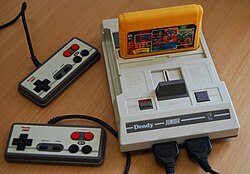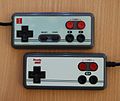Dendy (console)
This article is written like a manual or guidebook. (February 2017) |
 | |
 The Dendy Junior with a cartridge and controllers | |
| Manufacturer | Micro Genius |
|---|---|
| Type | Video game console |
| Release date |
|
| Discontinued | 1998 |
| Units sold | 1.5 million – 6 million |
| Media | ROM cartridge |
| CPU | MOS Technology 6502 |
Dendy (Russian: Де́нди) is a Taiwanese hardware clone of the Family Computer (the Japanese version of the Nintendo Entertainment System), produced for the Russian market. It was released in 1992 by the Steepler company. The Dendy was easily the most popular video game console of its time in the former USSR region and enjoyed a degree of fame roughly equivalent to that experienced by the NES/Famicom in North America, Japan and Western Europe. In 1992, Dendy was selling in the Russian Federation for 39,000 rubles[1] (roughly 70–80 USD[2]); by 1994, over one million Dendy units were sold in Russia,[3] and the price was roughly $35.[citation needed]
History[]
Victor Savyuk (Russian: Виктор Савюк) first heard about Nintendo in 1991 when it was enjoying great commercial success with the NES console in Japan and the Western world. Hoping to repeat this success in Russia in the period immediately following the collapse of the USSR, Savyuk began importing counterfeit consoles from Asia to Russia. Although it was already possible to buy Famicom clones and NES consoles from local distributors, Savyuk began making plans to invent, register and promote his own brand. Seeking a company in Moscow that would be able to manage sales and distribution locally, in 1992 he stumbled upon Steepler (Russian: Стиплер) which agreed to manage this aspect of the business. The new console would be called the Dendy (Russian: Денди) and its logo was created by Ivan Maximov.[4]
The Dendy first appeared on the market in December 1992, selling at the price of 39,000 rubles (equivalent to US$175 in 2020).[1] Marketing for the console led to a series of animated television advertisements with the phrase "Dendy, Dendy! We all love Dendy! Dendy – everyone plays!"[nb 1][5] Later, a TV show was launched called "Dendy - The New Reality".[nb 2] By April 1993, Steepler had four regional distributors and had generated 500 million rubles in revenue (equivalent to US$1.3 million in 2020).[6]
For a while, the Dendy's main competitors were similar products from China. It was not until November 1993 that competitors, the Sega consoles imported by Nisho Iwai and distributed by Forrus, were introduced to the market.[7] Steepler reorganized in early 1994, resulting in the separation and creation of the Lamport company, which later manufactured the Kenga, another Famicom Clone. By mid-1994, Steepler had already sold 1 million Dendy consoles and was selling between 100,000 and 125,000 more per month with a revenue of $5 million.[3] At this time, the price of the consoles had dropped to roughly $30–$35.[citation needed]
In August 1994, Incombank and Steepler announced plans to start up a joint business venture called Dendy, in which Incombank would contribute capital and receive 30% of profits.[8] At the end of 1994, two more Dendy rivals (also NES clones) appeared: the Kenga, manufactured by Lamport, and the Bitman, distributed by R-Style and Subor (Russian: Сюбор).[9] In November 1994, the newly created Dendy company signed an agreement with Nintendo, in which they were forbidden from promoting Sega products and given exclusive distribution rights to the SNES in Russia.[10] There was a clause in the contract, that Nintendo had no claims against the Dendy console and therefore Steepler could continue to trade them.[4] Due to many problems Steepler collapsed in 1996. The subsidiary AOZT Dendy continued to sell the consoles until 1998, when they ceased operations.[11]
Modern Dendy consoles, which can still be found alongside Chinese products in many markets, are manufactured in China and have no relation to the Steepler company. They are also lower quality clones using NOAC SoCs which suffer from various issues, the most common one being no expansion audio (something the Dendy Jr suffered from). Many also have the 25% and 50% pulse waves swapped. Dendy consoles had cloned but otherwise separate CPU and PPU.[citation needed]
Technical specifications[]
The technical specifications of the Dendy are mostly consistent with those of the PAL version of the NES, but there are some differences in design and execution.
Processor[]
- 6527P, Ricoh 2A03-compatible. 8-bit, 1.773447 MHz.
The exact chipset and implementation differed depending on the model and time of release (while maintaining software compatibility). Most often in the console were two chips manufactured by UMC — UA6527P (CPU) and UA6538 (PPU), which have been integrated to be compatible with the 6502 processor and the rest of the logic. Later editions consolidated the design of all previous implementations into a single, open-frame chip.
Sound[]
- Built-in pAPU, 5 channels.
- Expansion audio, such as VRC6, VRC7 and FDS audio, from pins 48 and 49 (Classic versions only)
Savegames[]
Savegames work just like they would on an official NES or Famicom where the cartridge needs to have battery backed Save RAM.[12] However, no Dendy cartridges were made which would contain battery-backed saves. No games that relied on that were sold, like most long RPGs.
Models[]
Dendy was produced in two main configurations: Dendy Classic and Dendy Junior. They have different console and controller designs. The Dendy Classic I and II models were rebranded variations of the Micro Genius IQ-501 and IQ-502 respectively, manufactured by TXC Corporation in Taiwan. The Dendy Junior was designed to resemble the Famicom. These are then divided into more subconfigurations, like Dendy Junior II, Dendy Junior IIP, Dendy Junior IVP, Dendy Classic II which may not be completely consistent between batches or regions.
Dendy has two video outputs, RF- (antenna) output, preset on Russia's second main television channel frequency, and composite RCA. Some consoles can be compatible with the PAL television standard, others with SECAM. Both the Classic and Junior variants may have one or two controllers packed in the box, with controllers being also sold separately. (Other designs of the gamepads were present in the market, different shapes including resembling that of the Sega Genesis.)
"Junior" gamepads can have front- or side-outcoming cable, and on the part of the console hard-wired or detachable. The sockets could be front or side. (Always side on Classic.) Systems with hard-wired controllers always had two of them, with an additional socket for light gun.
The Junior may or may not have Start and Select buttons on the second controller, but it does have turbo buttons. They never have a microphone. Classic's pads always have Start and Select, and also always have turbo buttons. The turbo speed, according to advertising booklets by Steepler, differs, the Junior being 7 repeats per second, Classic 20 per second. The Dendies with a P suffix in their name include a light gun.

Dendy Junior
Dendy Junior controller
Dendy Junior II
Dendy Junior II interfaces

Dendy Junior II controllers
Game cartridges[]

Cartridges look very similar to the original Famicom (the Japanese origin of the NES) cartridges. Just like with the Famicom, the original NES cartridges are mechanically incompatible with the Dendy console due to a different form factor of the PCB and the outer hull. Most of the games sold for Dendy consoles have been bootlegs or copies of classic NES games. Among them are multicarts, sometimes with a few games replicated many times or separated by levels with ability to choose any of them, sometimes with the sprites or maps slightly altered. There are very few original Russian, Taiwanese or Chinese products, as they are most notable for pirated and bootlegged products. Among the games is the Super Mario Bros. series, which includes the three original Mario productions from Nintendo, along with a series of unlicensed Mario games, most of which are just other Famicom games with the main character replaced with Mario sprites. Examples of an originally programmed (but still trademark-infringing) game include the infamous Somari, which is a port of Sonic the Hedgehog with Sonic's sprite replaced by Mario's, and another one is the unlicensed 8-bit clone of the SNES's Super Mario World game.
Reception[]
Dendy prices during 1992 began at 39,000 rubles (roughly $94).[2] In relation to contemporary income levels, prices in this range were the equivalent of several months' salary, and this effectively put the Dendy out of reach of most individuals.[13] As sales increased, however, Steepler was able to reduce prices such that by 1994 with over one million Dendy units sold, the price had dropped to roughly $35.[3]
As for the sale of Dendy, most sources say that from 1.5 to 2 million consoles were sold in Russia.[14] Some sources say that around 6 million consoles were sold in Russia and in the other former USSR countries.[4]
In Russia in the modern day, nostalgia-oriented retrogaming enthusiasm has provoked a resurgence of interest in the Dendy console.[15]
Notes[]
References[]
- ^ Jump up to: a b "Мелкооптовая торговля" [Wholesale Trade] (in Russian). Kommersant. 21 December 1992. Archived from the original on 2019-04-16. Retrieved 2019-12-03.
- ^ Jump up to: a b Pichugin, Igor Z. "Steepler начал продавать Dendy — Московская фирма начинает большую видеоигру". Kommersant. 18 December 1992.
- ^ Jump up to: a b c "Полугодовые итоги по бизнесу Dendy — К "русскому Nintendo" добавилась японская Sega" [Talk of Japanese competitor Sega entering Russian market] (in Russian). Kommersant. July 19, 1994. Retrieved 2010-03-26.
- ^ Jump up to: a b c "Приставка Dendy: Как Виктор Савюк придумал первый в России поп-гаджет". secretmag.ru.
- ^ "Dendy Останкино, 1993 Реклама" [Dendy Ostankino, 1993 Advertisement] (in Russian). Retrieved 2019-12-03.
- ^ Обзор российского рынка видеоигр — Бурный рост приводит к аномалиям [Russian market sees explosion in demand for video games] (in Russian). Kommersant. 14 April 1993. Retrieved 2009-06-14.
- ^ http://game-exe.org/index.php?n=Exe.Exe001InterviewSEGA
- ^ В "новой реальности" главное выбрать верные ориентиры [It is most important to pick right guide for the 'new reality'] (in Russian). Kommersant. 29 October 1994. Retrieved 2009-06-14.
- ^ "История приставок Bitman | Записки геймера".
- ^ Реклама: казнить нельзя помиловать [Talk of battle for video game console market being merciless] (in Russian). Kommersant. 26 November 1994. Retrieved 2009-06-14.
- ^ "Dendy — GameWiki".
- ^ "nesdev.com - Information". forums.nesdev.com.
- ^ Schillinger, Liesl. "News - Forum: The death of childhood in Russia." The Ottawa Citizen. Pg.B3. 24 October 1993.
- ^ "История Dendy. Как "спиратить" целую консоль". 21 March 2020.
- ^ Toohey, Nathan. "Retro-kitsch in Moscow's time machine." The Moscow News. 11 March 2010.
See also[]
External links[]
![]() Media related to Dendy (console) at Wikimedia Commons
Media related to Dendy (console) at Wikimedia Commons
- Nintendo Entertainment System hardware clones
- Products introduced in 1992
- Video gaming in Russia






